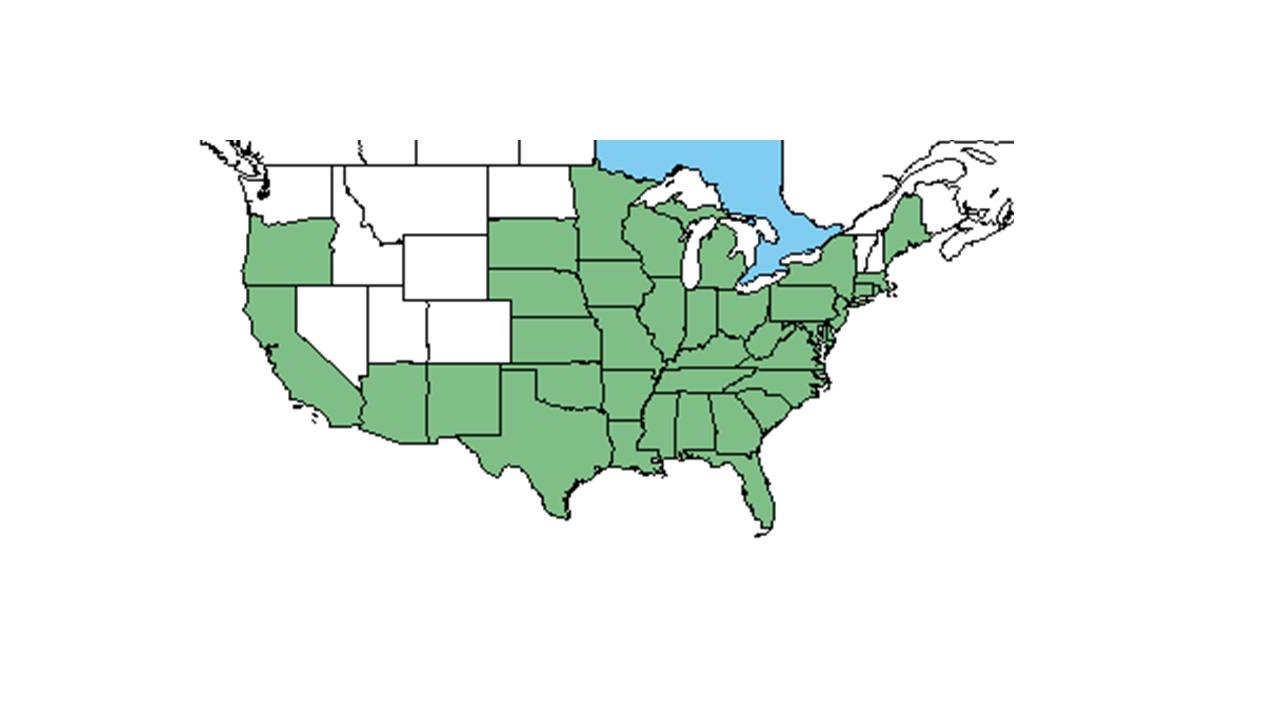Plantago virginica
| Plantago virginica | |
|---|---|

| |
| Photo by John R. Gwaltney, Southeastern Flora.com | |
| Scientific classification | |
| Kingdom: | Plantae |
| Division: | Magnoliophyta - Flowering plants |
| Class: | Magnoliopsida – Dicotyledons |
| Order: | Plantaginales |
| Family: | Plantaginaceae |
| Genus: | Plantago |
| Species: | P. virginica |
| Binomial name | |
| Plantago virginica L. | |

| |
| Natural range of Plantago virginica from USDA NRCS Plants Database. | |
Common name: Virginia plantain
Contents
Taxonomic notes
Synonyms: Plantago virginica var. virginica; P. virginica var. viridescens Fernald
Description
"Perennial or annual acaulescent or caulescent herbs. Leaves all basal, or opposite on freely branched stems. Spike bracteate. Calyx actinomorphic, sepals 4, united only at the base; corolla actinomorphic, united ½ or more its length, lobes 4, erect, spreading or reflexed, papery, persistent in fruit. Stamens 4, barely to long exserted; stigma 2-cleft, ovary superior. Capsule circumscissile, 2-locular, 2 to many seeded." - Radford et al 1964
"Acaulescent winter annual with a tap root, often dioecious. Leaves pubescent, oblanceolate to elliptic, the longest ones 2-15 cm long, 0.5-4 cm wide acute to obtuse, irregularly dentate to nearly entire, base attenuate; petioles usually purple at the base, obscured by decurrent blade tissue. Scape hollow, terete, 4-18 cm long. Spike 1-15 cm long, densely flowered and fruited. Bracts and sepals obtuse, calyx lobes 2-2.3 mm long, about equaling to 2X as long as the bracts, margins hyaline; corolla lobes 1.5-2.9 mm long, about equal to tube. Stamens and stigma well exserted. Capsule 2-seeded, 2-3 mm long, circumscissile near the middle. Seeds light brown, nearly smooth, lustrous, grooved on the back, the hilum inconspicuous, ellipsoid, 1.5-1.8 mm long."- Radford et al 1964
Distribution
Ecology
Habitat
A natural community of P. virginica is a frequently burned mature longleaf pine-wiregrass community (FSU Herbarium). In human disturbed areas it has been documented to grow in a mowed grassy roadside, old biocontrol plots, and a lawn near a T.V. tower (FSU Herbarium). It has been observed growing with Pinus palustris and Aristida (FSU Herbarium). It is known to grow in loamy soil and sand of disturbed roadsides (FSU Herbarium).
Phenology
It has been recorded to bloom in March, April and December (FSU Herbarium).
Seed bank and germination
When exposed to natural seasonal changes, buried seeds of P. virginica exhibit an annual conditional dormancy/non-dormancy cycle (Baskin et al. 2003). Dormancy is broken in the summer, with the germination season extending from September to November (Baskin et al. 2003). Peak germination for P. virginica occurs in October (Baskin et al. 2003).
Conservation and Management
Cultivation and restoration
Photo Gallery
References and notes
Baskin, C. C., J. M. Baskin, et al. (2003). "Seasonal changes in the germination responses of buried seeds of three native eastern North American winter annuals." Plant Species Biology 18: 59-66.
Florida State University Robert K. Godfrey Herbarium database. URL: http://herbarium.bio.fsu.edu. Last accessed: July 2015. Collectors: Robert K. Godfrey, Andre F. Clewell, R.A. Norris, R.F. Doren, R. Komarek, Loran C. Anderson. States and Counties: Florida: Gadsden, Holmes, Leon, Liberty, Wakulla, Washington. Georgia: Grady, Thomas. Compiled by Tall Timbers Research Station and Land Conservancy.
Radford, Albert E., Harry E. Ahles, and C. Ritchie Bell. Manual of the Vascular Flora of the Carolinas. 1964, 1968. The University of North Carolina Press. 974-977. Print.